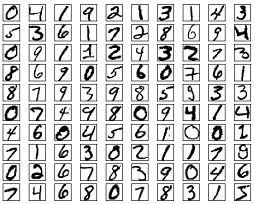Logistic Regression with Eager API
A logistic regression implemented using TensorFlow's Eager API.
- Author: Aymeric Damien
- Project: https://github.com/aymericdamien/TensorFlow-Examples/
MNIST Dataset Overview
This example is using MNIST handwritten digits. The dataset contains 60,000 examples for training and 10,000 examples for testing. The digits have been size-normalized and centered in a fixed-size image (28x28 pixels) with values from 0 to 1. For simplicity, each image has been flattened and converted to a 1-D numpy array of 784 features (28*28).

More info: http://yann.lecun.com/exdb/mnist/
from __future__ import absolute_import, division, print_function
import tensorflow as tf
import tensorflow.contrib.eager as tfe
# Set Eager API
tfe.enable_eager_execution()
# Import MNIST data
from tensorflow.examples.tutorials.mnist import input_data
mnist = input_data.read_data_sets("/tmp/data/", one_hot=False)
Extracting /tmp/data/train-images-idx3-ubyte.gz
Extracting /tmp/data/train-labels-idx1-ubyte.gz
Extracting /tmp/data/t10k-images-idx3-ubyte.gz
Extracting /tmp/data/t10k-labels-idx1-ubyte.gz
# Parameters
learning_rate = 0.1
batch_size = 128
num_steps = 1000
display_step = 100
# Iterator for the dataset
dataset = tf.data.Dataset.from_tensor_slices(
(mnist.train.images, mnist.train.labels)).batch(batch_size)
dataset_iter = tfe.Iterator(dataset)
# Variables
W = tfe.Variable(tf.zeros([784, 10]), name='weights')
b = tfe.Variable(tf.zeros([10]), name='bias')
# Logistic regression (Wx + b)
def logistic_regression(inputs):
return tf.matmul(inputs, W) + b
# Cross-Entropy loss function
def loss_fn(inference_fn, inputs, labels):
# Using sparse_softmax cross entropy
return tf.reduce_mean(tf.nn.sparse_softmax_cross_entropy_with_logits(
logits=inference_fn(inputs), labels=labels))
# Calculate accuracy
def accuracy_fn(inference_fn, inputs, labels):
prediction = tf.nn.softmax(inference_fn(inputs))
correct_pred = tf.equal(tf.argmax(prediction, 1), labels)
return tf.reduce_mean(tf.cast(correct_pred, tf.float32))
# SGD Optimizer
optimizer = tf.train.GradientDescentOptimizer(learning_rate=learning_rate)
# Compute gradients
grad = tfe.implicit_gradients(loss_fn)
# Training
average_loss = 0.
average_acc = 0.
for step in range(num_steps):
# Iterate through the dataset
try:
d = dataset_iter.next()
except StopIteration:
# Refill queue
dataset_iter = tfe.Iterator(dataset)
d = dataset_iter.next()
# Images
x_batch = d[0]
# Labels
y_batch = tf.cast(d[1], dtype=tf.int64)
# Compute the batch loss
batch_loss = loss_fn(logistic_regression, x_batch, y_batch)
average_loss += batch_loss
# Compute the batch accuracy
batch_accuracy = accuracy_fn(logistic_regression, x_batch, y_batch)
average_acc += batch_accuracy
if step == 0:
# Display the initial cost, before optimizing
print("Initial loss= {:.9f}".format(average_loss))
# Update the variables following gradients info
optimizer.apply_gradients(grad(logistic_regression, x_batch, y_batch))
# Display info
if (step + 1) % display_step == 0 or step == 0:
if step > 0:
average_loss /= display_step
average_acc /= display_step
print("Step:", '%04d' % (step + 1), " loss=",
"{:.9f}".format(average_loss), " accuracy=",
"{:.4f}".format(average_acc))
average_loss = 0.
average_acc = 0.
Initial loss= 2.302584887
Step: 0001 loss= 2.302584887 accuracy= 0.1172
Step: 0100 loss= 0.952338457 accuracy= 0.7955
Step: 0200 loss= 0.535867393 accuracy= 0.8712
Step: 0300 loss= 0.485415280 accuracy= 0.8757
Step: 0400 loss= 0.433947206 accuracy= 0.8843
Step: 0500 loss= 0.381990731 accuracy= 0.8971
Step: 0600 loss= 0.394154936 accuracy= 0.8947
Step: 0700 loss= 0.391497582 accuracy= 0.8905
Step: 0800 loss= 0.386373103 accuracy= 0.8945
Step: 0900 loss= 0.332039326 accuracy= 0.9096
Step: 1000 loss= 0.358993769 accuracy= 0.9002
# Evaluate model on the test image set
testX = mnist.test.images
testY = mnist.test.labels
test_acc = accuracy_fn(logistic_regression, testX, testY)
print("Testset Accuracy: {:.4f}".format(test_acc))
Testset Accuracy: 0.9083